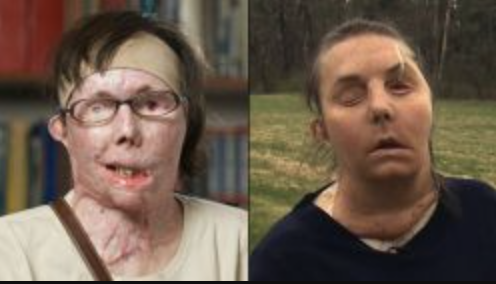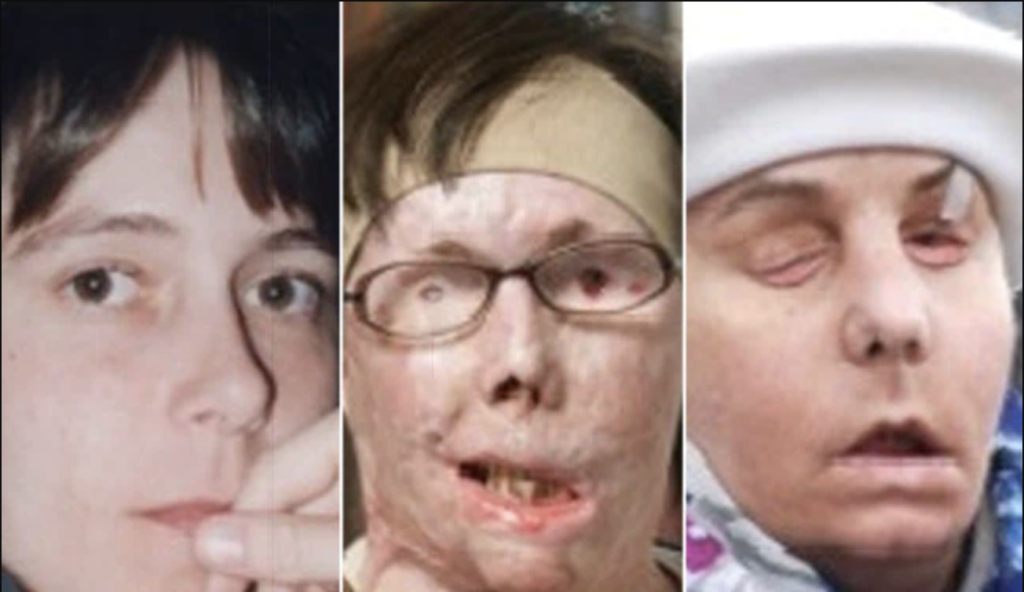It is not something that Carmen Blandin Tarleton want to go backward. It is a struggle for her to have a third face.
After suffering dozens of operations and a face transplant in 2013, Tarleton was able to regain part of her life. This was twelve years after her estranged husband attacked her with a baseball bat and lye, causing her to lose much of her body. She was even able to play the piano. Additionally, she was able to navigate her way about Manchester, New Hampshire, thanks to a synthetic cornea that assisted her in seeing out of all of her eyes.
Rejection episodes that were successfully treated by medical professionals have caused the features of her new face to swell over the course of many years. Tarleton’s immune system is completely rejecting her face at this point, when she is 51 years old, with her blood arteries having been severed and her facial tissue browning and gradually withering.
As her body refuses to accept a transplant, a woman fights for a third face.

In the span of three months, Carmen Blandin Tarleton had close to forty surgical procedures.
It is not something that Carmen Blandin Tarleton want to go backward. It is a struggle for her to have a third face.
After suffering dozens of operations and a face transplant in 2013, Tarleton was able to regain part of her life. This was twelve years after her estranged husband attacked her with a baseball bat and lye, causing her to lose much of her body. She was even able to play the piano. Additionally, she was able to navigate her way about Manchester, New Hampshire, thanks to a synthetic cornea that assisted her in seeing out of all of her eyes.
Rejection episodes that were successfully treated by medical professionals have caused the features of her new face to swell over the course of many years. Tarleton’s immune system is completely rejecting her face at this point, when she is 51 years old, with her blood arteries having been severed and her facial tissue browning and gradually withering.
Because of this, she is now forced to confront two challenging options: either she will get a new face or, if her tissue fails quickly, she will undergo reconstruction of her original face, which would result in her returning to the deformities she left behind at the beginning of the current decade.
In an interview with the Boston Globe, she said, “We all know that we are in uncharted waters.” I would want to avoid having to go through the experience of a catastrophic collapse.

Organs that have been transplanted, such as kidneys, hearts, and lungs, often have a short lifespan in the environment in which they are placed. The Associated Press claimed that there are no long-term studies or risk assessments to advise surgeons in the surgery of face transplantation, which has only been performed around forty times globally. However, medical professionals warn that the area of face transplantation is still in its experimental stage.
In an interview with the Globe, Bohdan Pomahac, who is also one of Tarleton’s surgeons and the head of plastic surgery transplantation at Boston’s Brigham and Women’s Hospital, said that “there are so many unknowns and so many new things we are discovering.” “Hoping that faces will last [the patient’s] lifetime is certainly not a realistic expectation,” the doctor said.
As stated by Brian Gastman, a transplant surgeon at the Cleveland Clinic who was responsible for the first face transplant in the United States in 2008, the number of unsuccessful face transplants has increased in the years that have passed since the treatment was first carried out. According to what he stated, “We all believe that every patient will likely need a re-transplant” at some time in the future.
There have been no cases of face transplant patients in the United States losing their given faces, according to the Associated Press. However, a guy in France underwent a second transplant after his body rejected the first one he received.
Tarleton has been vocal about her assault and recovery, which started a few hours after her estranged husband beat her with a baseball bat and bathed her body with lye, and which resulted in the burning of eighty percent of her body and left her permanently blind.
The Globe said that she had approximately forty surgical procedures in a span of three months. When she got a donor’s neck and face skin, nose, lips, and a bundle of muscles, nerves, and arteries, her immune system was sent into a state of shock. This was compounded by the fact that she had undergone dozens of blood transfusions.
Her medical professionals came up with a risky solution: they turned down her immune system in order to give her new face a chance, but this strategy put her at risk of contracting an infection.
The plan was successful, and she has been able to make progress in her life as a result. The grandkids are now included in it.
She is now waiting for a decision about whether or not she will proceed with another transplant or if she will return to her deformed face. The fact that her immune system has healed gives her doctors reason to be optimistic. Other problems, however, have come up. Her artificial cornea eventually failed, and as a result, she is almost completely blind. It was her intention to have a guide dog.
According to what she shared with the Globe, “These are not things that happen very often, but when things go wrong, you have to deal with it regardless.” I will return to the position I was in before. That is a mystery to me. I am going to make it through this.”
Nevertheless, the transplant has provided Tarleton with a significant amount of pain relief. She had been suffering from neck scars that made it difficult for her to move her head. After one year, she gradually decreased the amount of painkiller medicine she was using. Since then, she has written a memoir and taught herself how to play the banjo.
In addition, she enjoys spending time at the piano, where she sings songs such as the classic “Desperado” by The Eagles. She does this while being apprehensive about which of her grandkids will be there to meet her in the future.




